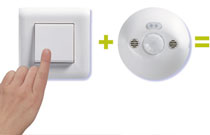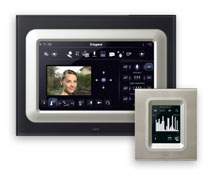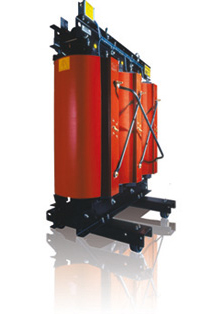Green Building - Green installations
ELECTRICAL PANEL
General matters concerning electrical panels
Electrical panels can improve energy performance in a home and thereby contribute to sustainable development and the green building approach. In light of its weight in energy consumption, building energy use is a major concern. Innovative solutions now exist to compensate reactive energy and measure building consumption.
The innovative offers brought out by the Legrand group concern the whole electrical panel. Everything from the installation head, to custom equipment boxes is available. As the electrical panel is the core of the electrical installation, it is logical that it is active in the deployment of solutions that aim to support sustainable development.
Reactive power compensation
Reactive power causes more energy to be consumed and in the end contributes to increasing CO2 emissions into the atmosphere and to more costly electricity bills. Under the yellow rate, reactive power is taken into account on an all-inclusive basis in the apparent subscribed rating, which increases the cost of electricity. The aim of compensation is to improve the power factor of an installation. It consists of setting up capacitor banks which are a source of reactive energy. So the power capacitor banks reduce the quantity of reactive energy supplied by the source. It is an eco-efficient solution that can make an immediate contribution to reaching the objectives set by the Grenelle Environment round table.
The conservation of natural resources and enhanced energy efficiency are the fundamental objectives of sustainable development and green building policies. Reactive power compensation can increase the energy efficiency of an installation. It is then possible to achieve a situation where only the active (useful) energy is carried, both on transport and distribution networks, and in customer networks. The use of reactive energy compensation equipment is a major source of savings. Such equipment enables an immediate and significant reduction in energy consumption and CO2 emissions.
The capacitor banks provide the reactive energy necessary for certain equipment to work (ballast, motors, etc.). They enable consumers to subscribe to a less expensive power supply contract with the utility supplier. Low Voltage and High Voltage capacitor banks are designed and sold by the Legrand group in France and around the world. They make a significant contribution to sustainable development.
These capacitors compensate the installation’s reactive energy while reducing energy bills. In effect, they reduce the apparent power required by the installation by around 20%. This can avoid the replacement of a substation that has reached its power capacity or to settle for a subscription that is limited by technical conditions (many subscribers on a single transformer). Capacitors are used in industrial buildings and large commercial buildings. With the same subscription, they can eliminate the reactive energy bill, optimise the subscription and increase the installation yield. In a 1000 m² supermarket, savings can reach €1128 per year. The savings in CO2 amount to 1.6 tonnes a year and the cost is amortised in just 2 years.
Measurement of energy consumption
Measuring one’s electricity consumption, displaying and recording it is the first step towards achieving sustainable savings that are justly considered as part of the green building approach. Measuring energy use is primordial if we want to take the right decisions in terms of sustainable development. Precise and regular measurements, combined with suitable corrective actions, are the key to efficient control over consumption and energy quality. When we monitor consumption, we make savings from 8 to 12%. So it is possible to set up simple but efficient action plans that will optimise performance.
Electricity meters and Legrand measuring stations meter the electrical power consumed on a single-phase or three-phase circuit. These meters are of course placed downstream of the metering by the power supplier. They display power use in kWh and total and partial active energy. The total and partial reactive power, the instant current and instant voltage etc. are also measured. The digital multi-function measurement stations also measure electrical values of low voltage applications.
THE MOSAIC PROGRAMME
Commercial products and solutions
ECO 1 and ECO 2 stand-alone sensor switches

The Legrand ECO1 and ECO2 stand-alone sensor switches can generate up to 55% energy savings according to a calculation of standard EN 15 193. They operate in automatic On/Off mode and measure the lighting level. Automatic On and Off functions are offered by the ECO1 mode. The ECO2 mode features a voluntary automatic On/Off action, according to standard EN 15 193. These sensor switches are easy to deploy, whether in a false ceiling, as a surface-mounted wall or ceiling fitting or as a flush-mounted unit.
According to a calculation based on standard EN 15 193, in mode ECO2 and for a 100m² area with natural lighting, these sensor switches can make considerable savings: Up to €80/year on green/yellow rate and up to €130/year on blue rate. What is more up to 120 kg of CO2 equivalent of pollution-generating gases can be saved. This example shows the significant role of a lighting management system in a sustainable development construction project. Stand-alone sensor switches generate an ROI within 2 years on average, and sustainable savings thereafter.
Lighting control system

The lighting control system represents a solution to reduce consumption in commercial applications and improve the global costs in terms of building maintenance. It includes ECO1 and ECO2 stand-alone sensors, the installation on BUS/SCS and stand-alone Radio/Zigbee sensors. This control system uses various lighting control solutions to make energy savings and ensure comfort of use. It is a genuine source of energy bill reductions and makes a valid contribution to sustainable development. The system can be used both in new buildings and renovations.
BUS/SCS sensors can be used individually or for centralised installations. Their deployment is simple and usually done in technical ceilings. These detectors and controls are by default configured intuitively. The settings are calculated either by the programming software or by customising them on the equipment, by touch controls or wireless configuration via the sensors. According to a calculation based on the EN 15 193 standard and for a 100 m² area with natural lighting, BUS/SCS variable controllers in technical ceilings can make substantial annual savings. For 100 m², the savings could reach €100/year on green/yellow rate and up to €160/year on blue rate, or 160 kg of CO2 equivalent/year of pollution-generating gases. BUS/SCS sensors therefore make an efficient contribution to the green building approach.
Stand-alone Radio/Zigbee sensors are generally used in addition to BUS/SCS devices. Such sensors are also used to independently control many different applications with individual controls or centralised control depending on the programming. The Office block equipment with its 230V Radio/Zigbee control will for example, control the office lighting and turn on / cut off PC power in parallel to the BUS/SCS. According to standard En 15 193 and with an ON/OFF lighting control, this type of detection can generate annual savings of up to €80/year at green/yellow rates and up to €130/year on blue rate. This represents 120 kg of CO2 equivalent per year. The BUS/SCS – Radio/Zigbee interface is used to connect a BUS/SCS installation and an additional Radio/Zigbee installation together.
Green sockets
Green sockets are eco-sockets that can equip each work station when connected to specific circuits. These power outlet sockets are easy to use and deploy (flush-mounted, surface-mounted, in the ceiling, in the floor or close by). The Mosaic range of green sockets can reduce the consumption of power outlet circuits by up to 25%. These sockets can shut down PCs (screen and central unit) or put them on standby, cut power to certain machines (photocopiers, network printers, fax machines, beverage dispensers) at night and at weekends.
They exist in different configurations: Small and large columns, floor boxes and blocks, notably office blocks and meeting room blocks. The latter integrate special energy-saving functions. For installations in renovated buildings, custom office blocks can integrate a time switch and RJ 45 outlets. Office blocks, columns and meeting room strips are ideal solutions for flexible commercial workspaces. The pleasing ergonomic and aesthetic features of these blocks offer a dash of elegance to office space. Green sockets are sustainable development equipment, therefore ideal for a green building approach.
Heating and temperature control

Heating represents almost 65% of the energy bills of main homes in France. Domestic heating is therefore the expenditure item to be considered in priority in the search to identify solutions for reducing electricity and natural gas bills. Gladly, sustainable solutions exist, thanks to the green building approach. So by regulating the temperature, it can be maintained at a selected value (temperature setting) while taking into account heat contributions from other source (sun, cooking equipment, etc.). This is possible through a regulation system that acts on the operation of the heating system.
The programme offers optimal control of the heating. A heating programming device such as an ambient thermostat can control the temperature of rooms according to the time of day. With an electronic weekly programme, this system can control the temperature on oil-fired, gas, and electric heating systems, whether in comfort mode, reduced or no-freeze mode. The system displays the current programme permanently. It can be rapidly connected using automatic terminals and is suited to regulating heat-radiating ceiling units and directly heated floors.
For a decent comfort temperature and to avoid waste, the building code has defined average temperature of housing as 19°C. A temperature of 16 to 17°C is sufficient in bedrooms during the night. It is also important to lower the temperature of a home when it is empty during the day. Changing the set temperature from 20°C to 19°C can reduce energy consumption by almost 7%.
Using a control system can therefore generate waste-free comfort and a reduction in energy consumption from 10 to 25%. Limiting emissions of pollutants and greenhouse gases makes a significant contribution to sustainable development. To ensure optimum performance, attractive energy savings and enhanced comfort, the heating system and installation must be efficient and modern.
In addition to efficient equipment, there are some simple actions that encourage energy efficiency and therefore sustainable development. Respecting boiler maintenance requirements for example, avoids deregulations that can lead to energy over-consumption. To facilitate heat distribution, radiators should not be covered and should be dusted regularly. It is also recommended to adapt the opening/closure of shutters and curtains according to the outside temperature and to the sunlight on glass separations. The Mosaic range offers automatic control of certain of these mechanisms.
EMERGENCY LIGHTING

Emergency lighting is an obligatory lighting installation for all public buildings and/or workplaces. This type of installation must be implanted in appliance with regulatory requirements to ensure both suitable signage and a minimum lighting level, to enable the evacuation of people in the event of an emergency. This system therefore provides signage for exists and evacuation routes in public buildings and workplaces, in the event the normal power supply is cut off. Its installation must include evacuation route lighting, ambient or anti-panic lighting for open spaces and halls, as well as stand-alone portable lighting for electrical rooms.
The new ECO2 addressable self-testing units satisfy the energy requirements of HEQ-VHEQ buildings. In effect, as they use LEDs, consumption by emergency evacuation lighting has dropped to 0.5W. The LED security blocks feature a low energy electronic circuit. For a total of 500 units, the savings can reach up to €1200/year and 1805 kg of CO2 equivalent on green/yellow rate and double this on blue rate. The units are equipped with addressable technology that enables easy control over the whole installation. In the sustainable development spirit, their labels and plastic light diffusers are recyclable. They are also suitable for HEQ/BBC (low energy) buildings to optimise energy performance.
HV/LV DRY-TYPE CAST RESIN TRANSFORMERS

Transformers are used to reduce the voltage on electric current delivered by a supplier, to an intensity suitable for the user’s electrical equipment. A dry-type transformer, contrary to a submerged transformer, is made up of moulded windings in a vacuum, inside an epoxy resin insulating casing. Cooling is done only by the surrounding air. These transformers offer reduced losses, which generate extensive electricity savings and a significant contribution to sustainable development and the green building approach.
They are designed to optimise energy efficiency. The resulting reduction in electricity use can reach 20% in relation to a conventional dry transformer for a building not in use (nights and weekends). Their use can therefore significantly lower the impact on the environment. This 20% reduction in energy use corresponds to 408 kg of CO2 per year for a 1250 kVA transformer.
In contrast to oil-based transformers, Zucchini transformers use “dry cast resin” technology. They can reduce the limitations, risk of fire and ejection of pollutants into the environment. They are therefore appropriate for sustainable development and do not need to be protected in a dedicated, isolated structure. They can also be more easily recycled at the end of their life. Zucchini transformers reduce energy consumption during phases of no activity in buildings. They can therefore generate significant savings. For a computer centre with two clusters of 250 m², the savings are in the order of €500 per year, or 816 kg of CO2 equivalent, which enables their cost to be amortised in under 5 years.
PHOTOVOLTAIC

Faced with the scarcity of fossil fuel supplies and increasing prices, the development of renewable energy sources, especially solar power, contributes to securing our energy supplies. Photovoltaic solar power is a buoyant sector. The Legrand group is contributing to its progress, notably in terms of safety. By assisting in the timely diversification of our energy resources, photovoltaic techniques are a pillar of sustainable development and the green building approach. Effectively, due to its abundance and inexhaustible supply, much greater use should be made of solar power as a resource.
Legrand proposes protection cabinets and components to protect and cut off DC electricity produced by photovoltaic panels. Safe deployment in residential applications is made easier with suitable solutions that combine UPS and protective devices in a single product. Such equipment can be used to build 3 kWp installations.
For commercial installations, the accent is naturally placed on safety, with MC4 type connections. This type of equipment enables reliable and durable connections. We can add emergency stop slap buttons to enable immediate shutdown. Legrand proposes weatherproof cabinets, protective devices, cut-off devices and UPS up to 14 kWp, both for DC and AC applications.
Photovoltaic energy generates no greenhouse gas pollution or waste. Its potential is infinite and therefore plays a major role in sustainable development. According to the International Energy Agency (IEA), a surface area of 145,000 km² (or 4% of the surface of the driest deserts) would be sufficient to satisfy the whole planet’s electricity needs. The IEA calculation shows that a photovoltaic installation connected to the network will produce an ROI within 1 to 3 years, depending on the amount of sunshine captured by the site.
GREEN BUILDING – Ecological construction
GREEN BUILDING – Components
GREEN BUILDING – Environment and climate
GREEN BUILDING – Certifications
SUSTAINABLE DEVELOPMENT AND THE ENVIRONMENTAL FOOTPRINT
GREEN BUILDING – Green installations
GREEN BUILDING – Eco-technologies and practices
GREEN BUILDING – Zero energy home and economic aspects
discover
World presence
Our CSR approach
Design at Legrand
Social networks